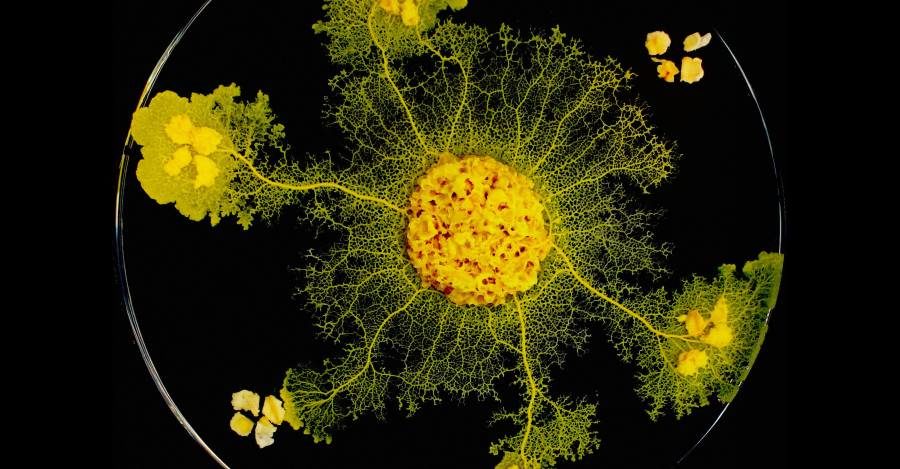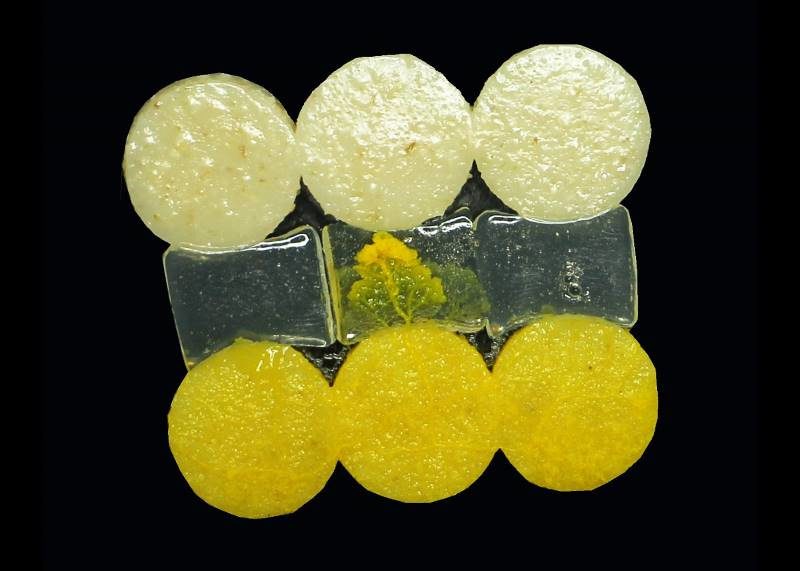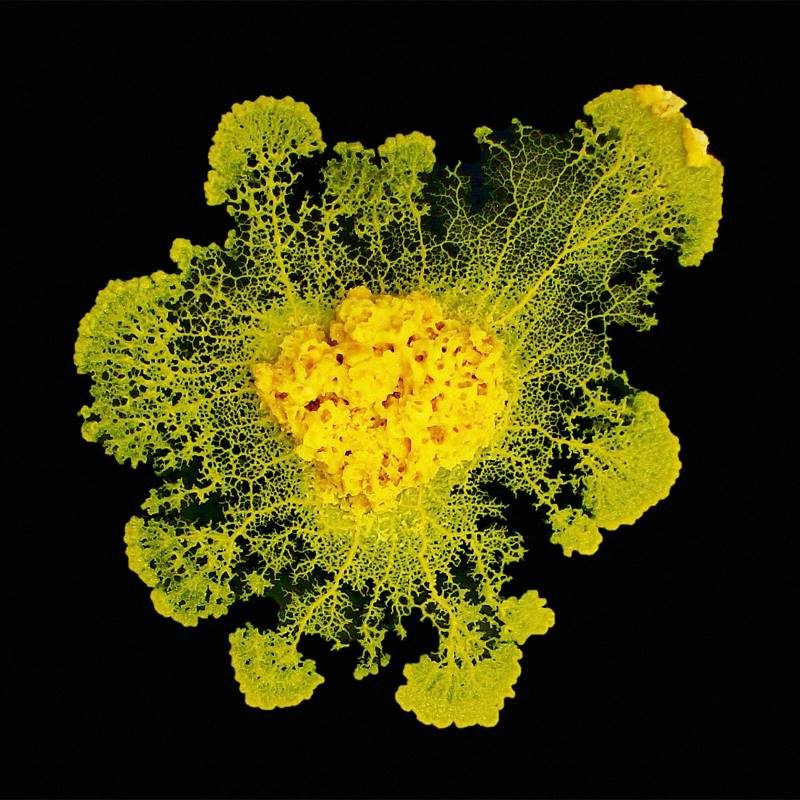
Slime molds are among the world's strangest organisms. Long mistaken for fungi, they are now classed as a type of amoeba. As single-celled organisms, they have neither neurons nor brains. Yet for about a decade, scientists have debated whether slime molds have the capacity to learn about their environments and adjust their behavior accordingly.
For Audrey Dussutour, a biologist at France's National Center for Scientific Research and a team leader at the Research Center on Animal Cognition at Université Paul Sabatier in Toulouse, that debate is over. Her group not only taught slime molds to ignore noxious substances that they would normally avoid, but demonstrated that the organisms could remember this behavior after a year of physiologically disruptive enforced sleep. But do these results prove that slime molds - and perhaps a wide range of other organisms that lack brains - can exhibit a form of primitive cognition?
Slime molds are relatively easy to study, as protozoa go. They are macroscopic organisms that can be easily manipulated and observed. There are more than 900 species of slime mold; some live as single-celled organisms most of the time, but come together in a swarm to forage and procreate when food is short. Others, so-called plasmodial slime molds, always live as one huge cell containing thousands of nuclei. Most importantly, slime molds can be taught new tricks; depending on the species, they may not like caffeine, salt or strong light, but they can learn that no-go areas marked with these are not as bad as they seem, a process known as habituation.
"By classical definitions of habituation, this primitive unicellular organism is learning, just as animals with brains do," said Chris Reid, a behavioral biologist at Macquarie University in Australia. "As slime molds don't have any neurons, the mechanisms of the learning process must be completely different; however, the outcome and functional significance are the same."
For Dussutour, "that such organisms have the capacity to learn has considerable implications beyond recognizing learning in nonneural systems." She believes that slime molds may help scientists to understand when and where in the tree of life the earliest manifestations of learning evolved.
Even more intriguingly, and perhaps controversially, research by Dussutour and others suggests that slime molds can transfer their acquired memories from cell to cell, said František Baluška, a plant cell biologist at the University of Bonn. "This is extremely exciting for our understanding of much larger organisms such as animals, humans and plants."
A History of Habituation
Studies of the behavior of primitive organisms go all the way back to the late 1800s, when Charles Darwin and his son Francis proposed that in plants, the very tips of their roots (a small region called the root apex) could act as their brains. Herbert Spencer Jennings, an influential zoologist and early geneticist, made the same argument in his seminal 1906 book Behavior of the Lower Organisms.
However, the notion that single-celled organisms can learn something and retain their memory of it at the cellular level is new and controversial. Traditionally, scientists have directly linked the phenomenon of learning to the existence of a nervous system. A number of people, Dussutour said, thought that her research "was a terrible waste of time and that I would reach a dead end."
She started studying the slimy blobs by putting herself "in the position of the slime mold," she said - wondering what it would need to learn about its environment to survive and thrive. Slime molds crawl slowly, and they can easily find themselves stuck in environments that are too dry, salty or acidic. Dussutour wondered if slime molds could get used to uncomfortable conditions, and she came up with a way to test their habituation abilities.
Habituation is not just adaptation; it's considered to be the simplest form of learning. It refers to how an organism responds when it encounters the same conditions repeatedly, and whether it can filter out a stimulus that it has realized is irrelevant. For humans, a classic example of habituation is that we stop noticing the sensation of our clothes against our skin moments after we put them on. We can similarly stop noticing many unpleasant smells or background sounds, especially if they are unchanging, when they are unimportant to our survival. For us and for other animals, this form of learning is made possible by the networks of neurons in our nervous systems that detect and process the stimuli and mediate our responses. But how could habituation happen in unicellular organisms without neurons?
Starting in 2015, Dussutour and her team obtained samples of slime molds from colleagues at Hakodate University in Japan and tested their ability to habituate. The researchers set up pieces of slime mold in the lab and placed dishes of oatmeal, one of the organism's favorite foods, a short distance away. To reach the oatmeal, the slime molds had to grow across gelatin bridges laced with either caffeine or quinine, harmless but bitter chemicals that the organisms are known to avoid.
"In the first experiment, the slime molds took 10 hours to cross the bridge and they really tried not to touch it," Dussutour said. After two days, the slime molds began to ignore the bitter substance, and after six days each group stopped responding to the deterrent.
The habituation that the slime molds had learned was specific to the substance: Slime molds that had habituated to caffeine were still reluctant to cross a bridge containing quinine, and vice versa. This showed that the organisms had learned to recognize a particular stimulus and to adjust their response to it, and not to push across bridges indiscriminately.

Of course, organisms can adapt to environmental changes in ways that don't necessarily imply learning. But Dussutour's work suggests that the slime molds can sometimes pick up these behaviors through a form of communication, not just through experience. In a follow-up study, her team showed that "naïve," non-habituated slime molds can directly acquire a learned behavior from habituated ones via cell fusion.
Unlike complex multicellular organisms, slime molds can be cut into many pieces; once they're put back together, they fuse and make a single giant slime mold, with vein-like tubes filled with fast-flowing cytoplasm forming between pieces as they connect. Dussutour cut her slime molds into more than 4,000 pieces and trained half of them with salt - another substance that the organisms dislike, though not as strongly as quinine and caffeine. The team fused the assorted pieces in various combinations, mixing slime molds habituated to salt with non-habituated ones. They then tested the new entities.
"We showed that when there was one habituated slime mold in the entity that we were forming, the entity was showing habituation," she said. "So one slime mold would transfer this habituated response to the other." The researchers then separated the different molds again after three hours - the time it took for all the veins of cytoplasm to form properly - and both parts still showed habituation. The organism had learned.
Hints of Primitive Cognition
But Dussutour wanted to push further and see whether that habituating memory could be recalled in the long term. So she and her team put the blobs to sleep for a year by drying them up in a controlled manner. In March, they woke up the blobs - which found themselves surrounded by salt. The non-habituated slime molds died, perhaps from osmotic shock because they could not cope with how rapidly moisture leaked out of their cells. "We lost a lot of slime molds like that," Dussutour said. "But habituated ones survived." They also quickly started extending out across their salty surroundings to hunt for food.
What that means, according to Dussutour, who described this unpublished work at a scientific meeting in April at the University of Bremen in Germany, is that a slime mold can learn - and it can keep that knowledge during dormancy, despite the extensive physical and biochemical changes in the cells that accompany that transformation. Being able to remember where to find food is a useful skill for a slime mold to have in the wild, because its environment can be treacherous. "It's very good it can habituate, otherwise it'd be stuck," Dussutour said.
More fundamentally, she said, this result also means that there is such a thing as "primitive cognition," a form of cognition that is not restricted to organisms with a brain.
Scientists have no idea what mechanism underpins this kind of cognition. Baluška thinks that a number of processes and molecules might be involved, and that they may vary among simple organisms. In the case of slime molds, their cytoskeleton may form smart, complex networks able to process sensory information. "They feed this information up to the nuclei," he said.
It's not just slime molds that may be able to learn. Researchers are investigating other nonneural organisms, such as plants, to discover whether they can display the most basic form of learning. For example, in 2014 Monica Gagliano and her colleagues at the University of Western Australia and the University of Firenze in Italy published a paper that caused a media frenzy, on experiments with Mimosa pudica plants. Mimosa plants are famously sensitive to being touched or otherwise physically disturbed: They immediately curl up their delicate leaves as a defense mechanism. Gagliano built a mechanism that would abruptly drop the plants by about a foot without harming them. At first, the plants would retract and curl their leaves when they were dropped. But after a while, the plants stopped reacting - they seemingly "learned" that no defensive response was necessary.

Chris Reid and his colleague Simon Garnier, who heads the Swarm Lab at the New Jersey Institute of Technology, are working on the mechanism behind how a slime mold transfers information between all of its parts to act as a kind of collective that mimics the capabilities of a brain full of neurons. Each tiny part of the slime mold contracts and expands over the course of about one minute, but the contraction rate is linked to the quality of the local environment. Attractive stimuli cause faster pulsations, while negative stimuli cause the pulsations to slow. Each pulsing part also influences the pulsing frequency of its neighbors, not unlike the way the firing rates of linked neurons influence one another. Using computer vision techniques and experiments that might be likened to a slime mold version of an MRI brain scan, the researchers are examining how the slime mold uses this mechanism to transfer information around its giant unicellular body and make complex decisions between conflicting stimuli.
Fighting to Keep Brains Special
But some mainstream biologists and neuroscientists are critical of the results. "Neuroscientists are objecting to the 'devaluing' of the specialness of the brain," said Michael Levin, a biologist at Tufts University. "Brains are great, but we have to remember where they came from. Neurons evolved from nonneural cells, they did not magically appear."
Some biologists also object "to the idea that cells can have goals, memories and so on, because it sounds like magic," he added. But we have to remember, he said, that work on control theory, cybernetics, artificial intelligence and machine learning over the last century or so has shown that mechanistic systems can have goals and make decisions. "Computer science long ago learned that information processing is substrate-independent," Levin said. "It's not about what you're made of, it's about how you compute."
It all depends on how one defines learning, according to John Smythies, the director of the Laboratory for Integrative Neuroscience at the University of California, San Diego. He is not persuaded that Dussutour's experiment with slime molds staying habituated to salt after extended dormancy shows much. "'Learning' implies behavior and dying is not that!" he said.
To Fred Kaijzer, a cognitive scientist at the University of Groningen in the Netherlands, the question of whether these interesting behaviors show that slime molds can learn is similar to the debate over whether Pluto is a planet: The answer depends as much on how the concept of learning is cast as on the empirical evidence. Still, he said, "I do not see any clear-cut scientific reasons for denying the option that nonneural organisms can actually learn".
Baluška said that many researchers also fiercely disagree about whether plants can have memories, learning and cognition. Plants are still considered to be "zombielike automata rather than full-blown living organisms," he said.
But the common perception is slowly changing. "In plants, we started the plant neurobiology initiative in 2005, and although still not accepted by the mainstream, we already changed it so much that terms like plant signaling, communication and behavior are more or less accepted now," he said.
The debate is arguably not a war about the science, but about words. "Most neuroscientists I have talked to about slime mold intelligence are quite happy to accept that the experiments are valid and show similar functional outcomes to the same experiments performed on animals with brains," Reid said. What they seem to take issue with is the use of terms traditionally reserved for psychology and neuroscience and almost universally associated with brains, such as learning, memory and intelligence. "Slime mold researchers insist that functionally equivalent behavior observed in the slime mold should use the same descriptive terms as for brained animals, while classical neuroscientists insist that the very definition of learning and intelligence requires a neuron-based architecture," he said.
Baluška said that as a result, it's not that easy to get grants for primitive-cognition studies. "The most important issue is that grant agencies and funding bodies will start to support such project proposals. Until now, the mainstream science, despite a few exceptions, is rather reluctant in this respect, which is a real pity."
To gain mainstream recognition, researchers of primitive cognition will have to demonstrate habituation to a broad range of stimuli, and - most importantly - determine the exact mechanisms by which habituation is achieved and how it can be transferred between single cells, Reid said. "This mechanism must be quite different to that observed in brains, but the similarities in functional outcomes make the comparison extremely interesting."



Comment: Other interesting instances of apparent learning: